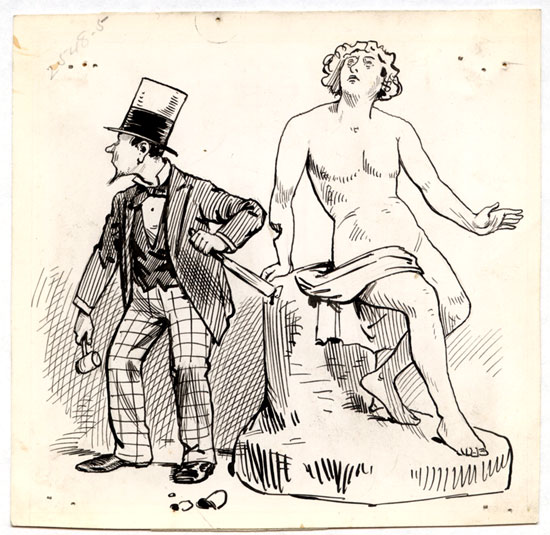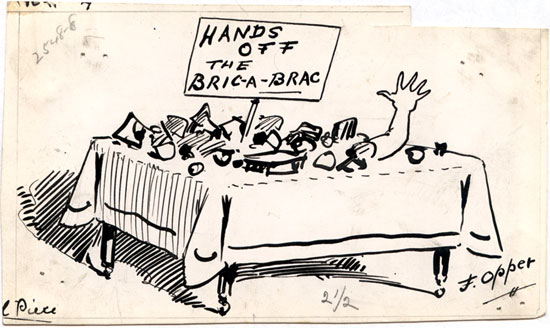What a treat. First, the panels (click any for bigger), which have been cut apart and trimmed, and are each about 6" wide, and drawn with pencil, pen, brush, and ink on illustration board:
When was the comic strip invented? That's a tough, unanswerable question, and people have argued over it for decades and will continue to far into the future. It's fair to say, however, that the comic strip as we know it today originated in American newspapers in the mid-1890s, as best exemplified by the work of R. F. Outcault, Rudolph Dirks, James Swinnerton, and Frederick Opper, who are generally credited as being the "four founding fathers" of the medium. These artists combined many elements which already existed, such as sequential picture stories told in panels, word balloons, and recurrent characters, into a popular art form which was unlike anything that had come before.
The piece shown here, The Relic Fiend by Frederick Opper, is a little earlier, and was almost certainly drawn for Puck Magazine between about 1885 and 1895, and as you can see, it's teetering right on the verge of being a comic strip proper. It's really more of a editorial cartoon told in a sequence of several spot illustrations. Because the panels have been trimmed, I have no way of knowing (until I track down a published copy) how they were arranged on the page (or, indeed, if there were more panels which didn't survive), but the bottom panel is inscribed "tail piece" on the verso, which suggests that it was published apart from the others, probably at the bottom of the page.
In any event, what a classic theme! This should be the official cartoon of the Getty Museum. It's an only slightly exaggerated look at the type of American aristocrat, like Henry Clay Frick, John Taylor Johnston, or Peter Widener, who plundered their way across Europe, merrily dismantling altarpieces and wresting sculptures out of niches along the way. And if there was anything Puck disliked more than robber barons, it was Catholics, so Opper managed to get in a hilarious dig at the Pope while he was at it.
Technically, these are impressive drawings, rendered with tightly-controlled pen and brushwork. The characters are beautifully drawn, and their poses are expressive, accurate and weighty. The high quality and fastidiousness make me place it a little later in Opper's Puck tenure. His earlier drawings tend to be a little wooden, while his later 20th Century work is downright chaotic.
Puck kept Opper very busy, and you can see copious amounts of his artwork from this period, as well as excellent work by other illustrators and stunning, gorgeous color printing, here and here at Google Books. For a contemporary look at Puck, see this painfully antiquated but excellent website.
Later, Opper moved to Hearst's New York Journal, and there he created his best known features, Happy Hooligan, And Her Name Was Maud, and Alphonse and Gaston, all three of which remain fresh, funny, and relevant today, as does the earlier editorial cartoon shown here.




5 comments:
Love the Pope's red nose.
This one's great! But I'm a sucker for any wordless narrative that has no problem getting the point across (it's harder than it looks, people).
As a side note, I have a copy of a very, very old Whiz comics from the early days of Captain Marvel, and he and Captain Marvel, Jr have a mock-polite pas de deux where CM says "After you, Alphonse," and CMJr says, "No, no, after you, Gaston."
The joke's a rather well-used trope, but the reference escaped me, and I'd forgotten it until now. And now I know.
see this painfully antiquated but excellent website.
That Web site was totally ahead of its time! It was totally like 1997!
I suppose the comic strip was one of those things around in the zeitgeist a long time before it was "invented," but no less an authority than E. H. Gombrich credits the invention of the comic strip to the Swiss artist Rodolphe Töpffer, who was publishing (though not in newspapers)humorous paneled naratives by the late 1820's.
That's basically true about Töpffer. And his work was published in the US, too.
However, even so, Töpffer was an outlier, and the comic strip really didn't become a "thing" until it was popularized in American newspapers and magazines like Puck and Judge.
Post a Comment